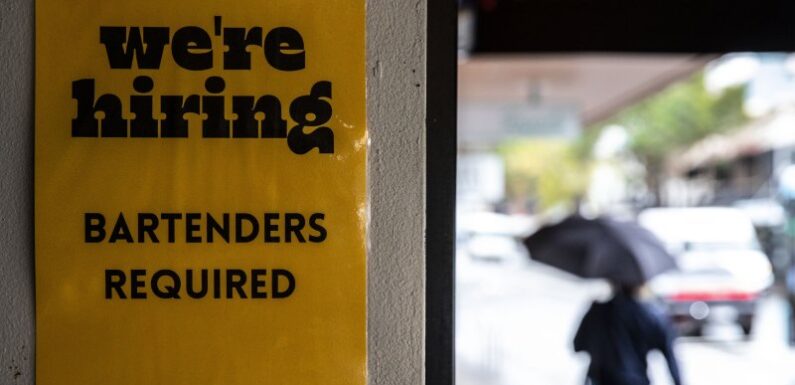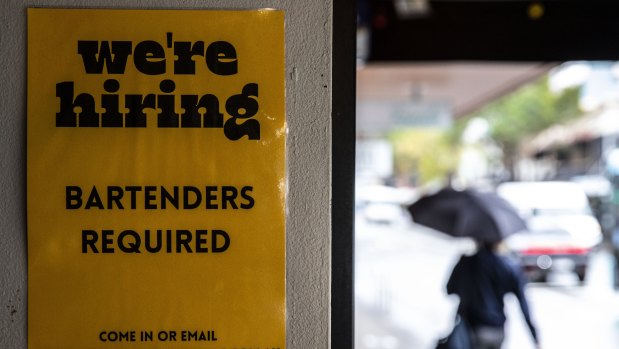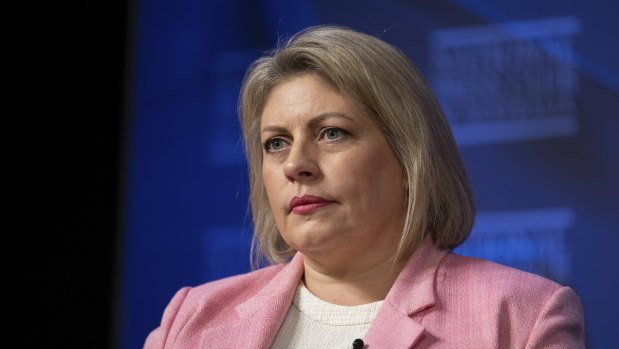
Save articles for later
Add articles to your saved list and come back to them any time.
The Reserve Bank may have to abandon any plans for further interest rate increases after figures showed the largest monthly fall in jobs since the COVID-19 pandemic and big jumps in unemployment in the key states of NSW and Queensland.
Just days after minutes of the RBA’s most recent meeting noted the jobs market was at a “turning point”, Australian Bureau of Statistics data showed a 0.2 percentage point lift in the unemployment rate to 3.7 per cent in July.
An unexpected drop in total employment suggests the Reserve Bank may not have to lift interest rates any further.Credit: Jessica Hromas
It was driven by a 14,600 fall in total employment, the largest monthly drop in jobs since October 2021. The total number of people without a job increased by 35,600.
Much of the damage was in NSW, where the jobless rate jumped by 0.4 percentage points to 3.3 per cent. The result would have been much worse but for a 0.3 percentage point fall in the number of people in work or looking for it.
The state shed almost 25,000 jobs in the month, including 17,600 full-time roles.
Queensland’s jobless rate increased by 0.8 percentage points to a 19-month high of 4.5 per cent. In Tasmania, unemployment leapt by 1.2 percentage points to 4.7 per cent – the highest rate since November 2021.
There remain pockets of strong jobs growth. The unemployment rate among women in Victoria fell to a record low of 3.3 per cent after another 5400 entered the jobs market. Over the past year, 90,600 more Victorian women have a job, of which two-thirds are in full-time employment.
The figures also suggest employers are squeezing more work out of their staff. Hours worked increased another 0.2 per cent after a 0.4 per cent increase in June. Over the past year, hours worked have jumped by 5.2 per cent.
The RBA, which is forecasting the jobless rate to climb as the economy slows, has held official interest rates at 4.1 per cent over the past two months.
In response to the lift in unemployment, financial markets wiped almost a full cent off the value of the Australian dollar on expectations the Reserve Bank will not need to lift interest rates any further.
EY chief economist Cherelle Murphy says the Reserve Bank no longer has a reason to lift interest rates.Credit: Alex Ellinghausen
EY chief economist Cherelle Murphy said the increase in unemployment was due to the Reserve Bank’s previous rate increases.
“Today’s jobs data is in line with Reserve Bank forecasts that unemployment will reach 3.9 per cent by the end of the year,” she said.
“This means the Reserve Bank no longer has a reason to increase rates any further – and it will reinforce the need for a pause in monetary tightening.”
Oxford Economics Australia lead economist Ben Udy said the deterioration in the jobs market still had a long way to run.
“Today’s data are likely to be the final nail in the coffin for any lingering expectations of a rate hike in September,” he said.
Separate data from the bureau released on Thursday also confirmed that despite low unemployment, wages growth remains largely in check.
It reported that the average weekly full-time adult wage reached $1838 in May. Over the past year, it has increased by 3.9 per cent, or $68 a week – the strongest annual growth since May 2013.
But over that period, inflation increased by 5.5 per cent based on the bureau’s monthly measure of inflation.
In the six months to May, average wages climbed by 1.7 per cent. In the six months before that, they were up by 2.1 per cent, suggesting a slowdown in wage growth.
The measure of weekly incomes is different from the wage price index, which showed a 3.6 per cent annual increase earlier in the week. These figures can be thrown out by changes in the composition of the workforce, such as the mix between full-time and part-time workers, so economists and the Reserve Bank focus on the wage price index.
The highest ordinary weekly wage remains in Western Australia, at $2039, just ahead of the ACT at $2028. The lowest is in Tasmania at $1619. Victorian full-time workers, at $1832.90 a week, take home one dollar more than their NSW counterparts.
Cut through the noise of federal politics with news, views and expert analysis from Jacqueline Maley. Subscribers can sign up to our weekly Inside Politics newsletter here.
Most Viewed in Politics
From our partners
Source: Read Full Article

